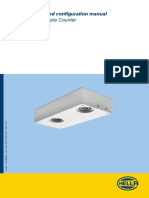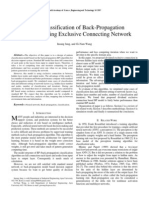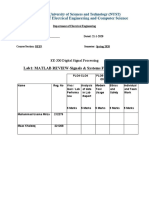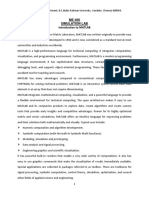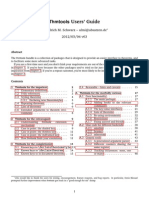Exercise 4 "Linear System Identification Using Neural Networks" Objective
Exercise 4 "Linear System Identification Using Neural Networks" Objective
Uploaded by
berkanhzrc67Copyright:
Available Formats
Exercise 4 "Linear System Identification Using Neural Networks" Objective
Exercise 4 "Linear System Identification Using Neural Networks" Objective
Uploaded by
berkanhzrc67Original Title
Copyright
Available Formats
Share this document
Did you find this document useful?
Is this content inappropriate?
Copyright:
Available Formats
Exercise 4 "Linear System Identification Using Neural Networks" Objective
Exercise 4 "Linear System Identification Using Neural Networks" Objective
Uploaded by
berkanhzrc67Copyright:
Available Formats
Gdansk University of Technology, Faculty of Ocean Engineering and Ship Technology
Modeling and Control of Dynamic Systems, Laboratory, M. H. Ghaemi
Exercise 4 Linear System Identification Using Neural Networks OBJECTIVE
Artificial Neural Networks (ANN) are widely applied nowadays for classification, identification, control, diagnostics, recognition, etc. They can be implemented for identification of dynamic systems. The objective of this exercise is identification of a dynamic system based on its response to standard signals used in the case of deterministic, continuous, linear and stationary systems. We concentrate on linear and adaptive linear networks.
REQUIREMENTS
A. Prerequisite knowledge: You are expected to know the following topics: 1. Neuron model and transfer functions used in ANN, 2. Perceptron and network architectures, 3. Training and learning methods (including adaptive training), 4. ANN linear system design, 5. Linear classification. B. MATLAB/SIMULINK 1. Using Neural Network Toolbox under MATLAB. To learn more about ANN and its application using MATLAB, you are strongly encouraged to read Chapters 2, 3 and 4 of Neural Network Toolbox for Use with MATLAB, written by Howard Demuth and Mark Beale and published by The Mathworks, Inc. It is available online: http://www.mathworks.com/access/helpdesk/help/pdf_doc/nnet/nnet.pdf. The next very useful reference is Neural Network Design written by Martin Hagan (see: http://hagan.ecen.ceat.okstate.edu/nnd.html).
LAYOUT
Recall the dynamic system of the first exercise. You should make such a neural network that is able to identify your system. After identifying the delivered model by differential equation, state variables or transfer function should be substituted by the designed neural network. 1. Define the system which should be identified. 2. Define the input and output signals. Take the step response of the system as your target. 3. Design the neural network using two methods: Linear System Identification (LSI) and Adaptive Linear System Identification (ALSI). 4. Calculate the errors. 5. Modify and adjust your network.
MATLAB/SIMULINK
The following new MATLAB commands and functions are necessary to be understood and applied in this exercise: MATLAB 5 adaptwh delaysig errsurf initlin length MATLAB 7 nn2lin and adapt cell errsurf nn2lin and init length
29
Gdansk University of Technology, Faculty of Ocean Engineering and Ship Technology
Modeling and Control of Dynamic Systems, Laboratory, M. H. Ghaemi
plotes plotep simulin solvelin sumsqr ----
plotes plotep nn2lin and sim newlind sumsqr nntool
REPORT
In addition to those points mentioned under Layout, your report should include: 1. Plots of all input and output signals (for system and network) 2. Plots of absolute and relative errors, 3. Investigation of learning rate influence on neuron response (for lr between 0.1 and 0.9) 4. Answers to the following questions: � Which method gives a better solution? Why? � Is there any other adaptive method? (Try to apply it).
EXAMPLE
Remark: MATLAB 5 commands and functions are used in the presented example. However, they can be easily adapted for MATLAB 7 using the table given under MATLAB/SIMULINK section of this exercise. Part One: Firstly, Linear System Identification (LSI) approach is presented under this example. Reconsider the presented example for Exercise 1. We take the output of that exercise as the input to the present exercise. Suppose that the system response to step function is given. Having the system response to step function we are able to train a linear neuron which models our system. In this case we do not need to introduce the transfer function/steady state representation of the system as it will be substituted by the linear neuron. Step 1: Defining the system should be identified: recalling the system of Exercise 1 we have: a=[ 0 1 ; -2 -0.5]; b=[0 ; 0.01]; c=[1 0]; d=0; sys=ss(a,b,c,d); Now, we define the system that should be identified: [x,time]=step(sys); T=x'; T defines the target which is system output signal. The input signal is step function: u(1:length(time))=1; The pattern, i.e. input to the neural network can be selected as the most recent three values of the system input signal: P=delaysig(u,0,2); Step 2: Choosing the weights and biases: to choose the weights and biases we have two ways: - plotting the error surface and contour:
30
Gdansk University of Technology, Faculty of Ocean Engineering and Ship Technology
Modeling and Control of Dynamic Systems, Laboratory, M. H. Ghaemi
Using errsurf we can calculate errors for a neuron with a range of possible weight and bias values. Then by using plotes this error surface with a contour plot underneath will be plotted. The best weight and bias values are those that result in the lowest point on the error surface. rw=-1:0.1:1; % defines the range of weights rb=-1:0.1:1; % defines the range of biases es=errsurf(u,T,rw,rb,purelin); plotes(rw,rb,es);
- direct calculation of weight and bias that result the minimum error using solvelin: [w,b]=solvelin (P,T) w= 5.5285e-017 9.7570e-005 4.8942e-003 b= 0 Step 3: Testing the model: the model is tested by calculating the network error. For this purpose at first we use simulin to simulate the linear neuron which models the original system: resp=simulin(P,w,b); To show the results, the output signal can be plotted: plot(time,resp,time,T,r+); grid
31
Gdansk University of Technology, Faculty of Ocean Engineering and Ship Technology
Modeling and Control of Dynamic Systems, Laboratory, M. H. Ghaemi
8 7 Network Output - System Output+ 6 5 4 3 2 1 0
x 10
-3
Network and System Output Signal
10 Time
15
20
25
Then the error signal is calculated: error=(100*(T-resp)./T); % relative error in % which can be also plotted to see the level of error signal:
Error Signal 200 0 -200 -400 -600 -800 -1000 -1200 -1400
Relative Error %
10 Time
15
20
25
Step 4: Solution: finally, the solution can be plotted on error surface by adding up the squared errors using sumsqr: sqe=sumsqr(T-resp); plotes(rw,rb,es) plotep(w(1,3),b,sqe)
32
Gdansk University of Technology, Faculty of Ocean Engineering and Ship Technology
Modeling and Control of Dynamic Systems, Laboratory, M. H. Ghaemi
As it is visible, solvelin found the minimum error solution. Part Two: The second part presents the Adaptive Linear System Identification (ALSI). The linear neuron is adapted to changes in the model it is trying to predict. The following steps are taken into account: Step 1: Defining the system should be identified: the same as mentioned in Part One.
x 10
-3
Input Signal to System
8 7 6 5 Input Signal 4 3 2 1 0
10 Time
15
20
25
33
Gdansk University of Technology, Faculty of Ocean Engineering and Ship Technology
Modeling and Control of Dynamic Systems, Laboratory, M. H. Ghaemi
8 7 6 5 4 3 2 1 0
x 10
-3
Output Signal of System
Output Signal
10 Time
15
20
25
Step 2: Defining the problem: Assume that the two most recent system inputs will be the inputs to the network as it tries to predict the system output T: P = delaysig(u,0,1); Step 3: Defining the network: initlin generates initial weights and biases for our neuron [w,b] = initlin(P,T); Step 4: Adapting the linear neuron: adaptwh simulates adaptive linear neurons. It takes initial weights and biases, an input signal and a target signal, and filters the signal adaptively. The output signal and the error signal are returned, along with new weights and biases. Let us use a learning rate equal 0.5: lr = 0.5; [resp,e,w,b] = adaptwh(w,b,P,T,lr); Now the output signal can be plotted with the target signal: plot(time,resp,time,T,'r') alabel('Time','Output (blue) Target (red)','Output and Target Signals') axis([0 10 0 1e-2])
Output and Target Signals 0.01 0.009 0.008 Output (blue) Target (red) 0.007 0.006 0.005 0.004 0.003 0.002 0.001 0 0 1 2 3 4 5 Time 6 7 8 9 10
34
Gdansk University of Technology, Faculty of Ocean Engineering and Ship Technology
Modeling and Control of Dynamic Systems, Laboratory, M. H. Ghaemi
Step 5: Calculating the error: A plot of the difference between the neurons output signal and the target signal shows how well the adaptive neuron works. plot(time,error,[min(time) max(time)],[0 0],':r') alabel('Time','Error','Error Signal') axis([0 15 0 1e-2])
Error Signal 0.01 0.009 0.008 0.007 0.006 Error 0.005 0.004 0.003 0.002 0.001 0 0 5 Time 10 15
Obviously, the adaptive method gives here more suitable solution with less error value. It is possible to calculate the energy of error in both cases to compare the results and selecting the proper network. Comment: The presented example has been prepared for running under MATLAB 5. If you use MATLAB 6 or 7, please use newlind and sim instead of solvelin and simulin, respectively, in the case of LSI. For ALSI application use newlin and adapt instead of initlin and adaptwh. You can also refer to the following m.files: Method LSI ALSI MATLAB 5 Ex4_1.m and Ex4_1_1.m Ex4_2.m MATLAB 7 Ex_4_1.m Ex_4_20.m (low level programming) and Ex_4_21.m (advanced level programming)
Additional work for willing students: Try to use a different step input signal and see how your defined ANN-based model responses to this new input. Make the same simulation using for example transfer function or steady space model. Then compare these two results and investigate how much your identified ANN-based model is reliable.
***
35
You might also like
- Guided Lab Exercise - Upload of Contacts From Google Sheets To SalesforceDocument22 pagesGuided Lab Exercise - Upload of Contacts From Google Sheets To SalesforceHerdian IrwantoNo ratings yet
- Dell Premium DES-4121 by - VCEplus 60q-DEMO PDFDocument19 pagesDell Premium DES-4121 by - VCEplus 60q-DEMO PDFDinaj AttanayakaNo ratings yet
- GetYourGuide Weekly Partner Forum CW 21 ShareoutDocument51 pagesGetYourGuide Weekly Partner Forum CW 21 ShareoutPanorama LuxNo ratings yet
- Mechanical Vibration Lab ReportDocument7 pagesMechanical Vibration Lab ReportChris NichollsNo ratings yet
- Matlab FileDocument16 pagesMatlab FileAvdesh Pratap Singh GautamNo ratings yet
- Revised - Intro. To PL1Document106 pagesRevised - Intro. To PL1Nagface100% (3)
- Inno PresentationDocument6 pagesInno PresentationAmisha Aliena60% (5)
- Manual APC R RS485 v2.70 enDocument120 pagesManual APC R RS485 v2.70 enCookNo ratings yet
- Movie Ticket BookingDocument78 pagesMovie Ticket BookingUma Shankar Yj100% (2)
- Lab 6 - Learning System Identification Toolbox of Matlab PDFDocument11 pagesLab 6 - Learning System Identification Toolbox of Matlab PDFAnonymous 2QXzLRNo ratings yet
- Soft Lab - Iii Ec506Document34 pagesSoft Lab - Iii Ec506Akanksha DixitNo ratings yet
- CSE Lab Manual Final 2019-20 P-IDocument42 pagesCSE Lab Manual Final 2019-20 P-IJerry boyNo ratings yet
- Neural Networks:: Basics Using MATLABDocument54 pagesNeural Networks:: Basics Using MATLABBob AssanNo ratings yet
- Analog SimulationDocument9 pagesAnalog SimulationMotaz Ahmad AmeenNo ratings yet
- Principles of Training Multi-Layer Neural Network Using BackpropagationDocument15 pagesPrinciples of Training Multi-Layer Neural Network Using Backpropagationkamalamdharman100% (1)
- Performance Evaluation of Artificial Neural Networks For Spatial Data AnalysisDocument15 pagesPerformance Evaluation of Artificial Neural Networks For Spatial Data AnalysistalktokammeshNo ratings yet
- (Notes) DESIGN FOR TESTABILITYDocument34 pages(Notes) DESIGN FOR TESTABILITYsarathkumarNo ratings yet
- Control Systems Laboratory: EXP (8) Analogue ComputerDocument9 pagesControl Systems Laboratory: EXP (8) Analogue ComputerAhmed Mohammed khalfNo ratings yet
- Pattern Classification of Back-Propagation Algorithm Using Exclusive Connecting NetworkDocument5 pagesPattern Classification of Back-Propagation Algorithm Using Exclusive Connecting NetworkEkin RafiaiNo ratings yet
- Exp - 4 - 5 (Prakash)Document10 pagesExp - 4 - 5 (Prakash)rajchaudhary8733No ratings yet
- Fault Detection System For Centrifugal Pumps Using Neural Networks and Neuro-Fuzzy TechniquesDocument9 pagesFault Detection System For Centrifugal Pumps Using Neural Networks and Neuro-Fuzzy TechniquesTetria AdwineldaNo ratings yet
- Soft Computing LabmanualDocument40 pagesSoft Computing LabmanualSonikeshNo ratings yet
- FRT 041 System IdentificationDocument6 pagesFRT 041 System Identificationعبدالسلام المبروك ابوزنادNo ratings yet
- Particle Swarm Optimization-Based RBF Neural Network Load Forecasting ModelDocument4 pagesParticle Swarm Optimization-Based RBF Neural Network Load Forecasting Modelherokaboss1987No ratings yet
- FLab-04 EXP4Document20 pagesFLab-04 EXP4Carl Kevin Cartijano100% (1)
- Least-Squares Methods For System IdentificationDocument4 pagesLeast-Squares Methods For System IdentificationMarco FierimonteNo ratings yet
- 2.004 Dynamics and Control Ii: Mit OpencoursewareDocument7 pages2.004 Dynamics and Control Ii: Mit OpencoursewareVishay RainaNo ratings yet
- Matlab Review PDFDocument19 pagesMatlab Review PDFMian HusnainNo ratings yet
- Cycle1 ManualDocument24 pagesCycle1 ManualSanthosh krishna. UNo ratings yet
- Real Timepower System Security - EEEDocument7 pagesReal Timepower System Security - EEEpradeep9007879No ratings yet
- Ali DSP Lab4Report.Document17 pagesAli DSP Lab4Report.Muhammad AliNo ratings yet
- 4.3.2.4 Lab - Internet Meter Anomaly DetectionDocument8 pages4.3.2.4 Lab - Internet Meter Anomaly DetectionNurul Fadillah JannahNo ratings yet
- CSE Journal (304111 TY-1)Document53 pagesCSE Journal (304111 TY-1)Akash BNo ratings yet
- Simulation Lab Manual 3107Document30 pagesSimulation Lab Manual 3107rajee101No ratings yet
- TC-202 SNSDocument34 pagesTC-202 SNSchinchouNo ratings yet
- Neural Network Based Estimation of Power Electronic WavesDocument6 pagesNeural Network Based Estimation of Power Electronic WavesJandfor Tansfg ErrottNo ratings yet
- Signals and Systems Using MatlabDocument68 pagesSignals and Systems Using MatlabSavio S100% (6)
- Neural Networks: MATLABDocument91 pagesNeural Networks: MATLABlaerciomosNo ratings yet
- ChapterThree NeuralNetworksDocument10 pagesChapterThree NeuralNetworksBO-IB MICHAELNo ratings yet
- Manual v8Document12 pagesManual v8nisakav739No ratings yet
- Modeling and Digital Simulation Case Studies: 3.1 Pre-Lab AssignmentDocument13 pagesModeling and Digital Simulation Case Studies: 3.1 Pre-Lab AssignmentLittle_skipNo ratings yet
- Character Recognition Using Neural Networks: Rókus Arnold, Póth MiklósDocument4 pagesCharacter Recognition Using Neural Networks: Rókus Arnold, Póth MiklósSharath JagannathanNo ratings yet
- Distance: Testing ADocument7 pagesDistance: Testing AthavaselvanNo ratings yet
- Matlab Aided Control System Design - ConventionalDocument36 pagesMatlab Aided Control System Design - ConventionalGaacksonNo ratings yet
- NARXDocument10 pagesNARXAmar Kant Gautam100% (1)
- DSP Lab 03Document10 pagesDSP Lab 03Akib Mohammad Azam ZaidiNo ratings yet
- SS Lab ManualDocument48 pagesSS Lab ManualKannan RNo ratings yet
- Design Neural Network Predictive Controller in SimulinkDocument9 pagesDesign Neural Network Predictive Controller in Simulinkrakheep123No ratings yet
- Lab 2: Quanser Hardware and Proportional Control: I. ObjectiveDocument7 pagesLab 2: Quanser Hardware and Proportional Control: I. ObjectiveAndré LeopoldinoNo ratings yet
- Lab 3Document11 pagesLab 3Vulpe FlorianNo ratings yet
- Realtime Power System Security Assessment Using Artifical Neural NetworksDocument13 pagesRealtime Power System Security Assessment Using Artifical Neural Networkssai0319No ratings yet
- Convolution Lab: 0.1 Short Discussion of Calculating ConvolutionsDocument7 pagesConvolution Lab: 0.1 Short Discussion of Calculating Convolutionsdervisis1No ratings yet
- PerceptronDocument6 pagesPerceptronChandra Mohan TripathyNo ratings yet
- Neural Networks in Automated Measurement Systems: State of The Art and New Research TrendsDocument6 pagesNeural Networks in Automated Measurement Systems: State of The Art and New Research TrendsEmin KültürelNo ratings yet
- 5.g 96 - Acceleration of MEMS Fault SimulationDocument5 pages5.g 96 - Acceleration of MEMS Fault SimulationVančo LitovskiNo ratings yet
- Nonlinear Control Feedback Linearization Sliding Mode ControlFrom EverandNonlinear Control Feedback Linearization Sliding Mode ControlNo ratings yet
- Line Drawing Algorithm: Mastering Techniques for Precision Image RenderingFrom EverandLine Drawing Algorithm: Mastering Techniques for Precision Image RenderingNo ratings yet
- Arduino Measurements in Science: Advanced Techniques and Data ProjectsFrom EverandArduino Measurements in Science: Advanced Techniques and Data ProjectsNo ratings yet
- Simulation of Some Power System, Control System and Power Electronics Case Studies Using Matlab and PowerWorld SimulatorFrom EverandSimulation of Some Power System, Control System and Power Electronics Case Studies Using Matlab and PowerWorld SimulatorNo ratings yet
- DEEP LEARNING TECHNIQUES: CLUSTER ANALYSIS and PATTERN RECOGNITION with NEURAL NETWORKS. Examples with MATLABFrom EverandDEEP LEARNING TECHNIQUES: CLUSTER ANALYSIS and PATTERN RECOGNITION with NEURAL NETWORKS. Examples with MATLABNo ratings yet
- Spline and Spline Wavelet Methods with Applications to Signal and Image Processing: Volume III: Selected TopicsFrom EverandSpline and Spline Wavelet Methods with Applications to Signal and Image Processing: Volume III: Selected TopicsNo ratings yet
- Advance Automatic ControlDocument2 pagesAdvance Automatic Controlberkanhzrc67No ratings yet
- Manual 1Document37 pagesManual 1Şahin GüngörNo ratings yet
- PrepositionsDocument7 pagesPrepositionsbashiutaNo ratings yet
- Itu Ayazaga YerleskesiDocument1 pageItu Ayazaga Yerleskesiberkanhzrc67No ratings yet
- Acoustic Fingerprinting SystemDocument41 pagesAcoustic Fingerprinting SystemAinuddin FaizanNo ratings yet
- Cdac Sample C-Cat PapersDocument77 pagesCdac Sample C-Cat Papersaits12395% (22)
- Service Manual: 5M67B ChassisDocument79 pagesService Manual: 5M67B ChassisElias moreira campos67% (3)
- Spss v12 Data AnalysisDocument17 pagesSpss v12 Data AnalysisChaitanya PopuriNo ratings yet
- Cyber Security MCQDocument9 pagesCyber Security MCQManjur Alam100% (1)
- Final Year Project Proposal Submission Form (2023-2024)Document10 pagesFinal Year Project Proposal Submission Form (2023-2024)talhaa42103No ratings yet
- GE8151 Python Programming Unit 2 Question Bank With Example CodeDocument37 pagesGE8151 Python Programming Unit 2 Question Bank With Example CodeN.VivekananthamoorthyNo ratings yet
- Xillybus Getting Started LinuxDocument24 pagesXillybus Getting Started LinuxMarius CîrsteaNo ratings yet
- Database Systems (Introduction)Document39 pagesDatabase Systems (Introduction)Alina Alina100% (1)
- Assignment4 DPLDocument4 pagesAssignment4 DPLnihalnetha249No ratings yet
- LogcatDocument34 pagesLogcataquilesvillacis125No ratings yet
- DP 900t00a Enu Powerpoint 04Document23 pagesDP 900t00a Enu Powerpoint 04Susmita DeyNo ratings yet
- Crack Is A Unix Password Cracking Program Designed To Allow System Administrators To Locate Users Who May Have Weak Passwords Vulnerable To A Dictionary AttackDocument3 pagesCrack Is A Unix Password Cracking Program Designed To Allow System Administrators To Locate Users Who May Have Weak Passwords Vulnerable To A Dictionary AttackPrestonKnapp01100% (2)
- Industrial AutomationDocument22 pagesIndustrial AutomationChamal JayasingheNo ratings yet
- MIS - Ethical and Social IssuesDocument38 pagesMIS - Ethical and Social IssuesSaikatiNo ratings yet
- ThmtoolsDocument48 pagesThmtoolsNishant PandaNo ratings yet
- PracticeDocument6 pagesPracticeakshat1apsNo ratings yet
- Unit-2 (Part-B) Notes of OOP (KOE-064) Subject (UML Use Case & Class Diagrams) by Updesh JaiswalDocument8 pagesUnit-2 (Part-B) Notes of OOP (KOE-064) Subject (UML Use Case & Class Diagrams) by Updesh Jaiswalviku9267No ratings yet
- Overview VP9Document44 pagesOverview VP9andres_polancoNo ratings yet
- PCS-221A X Instruction Manual en Overseas General X R1.00 (En ZNKZ0103.0086.0001)Document185 pagesPCS-221A X Instruction Manual en Overseas General X R1.00 (En ZNKZ0103.0086.0001)Ricchie Gotama SihiteNo ratings yet
- DX DiagDocument30 pagesDX DiagJuanCarlosHBazánNo ratings yet
- SSH To Beaglebone Black Over Usb PDFDocument13 pagesSSH To Beaglebone Black Over Usb PDFMochammad Solikhul AnasNo ratings yet
- Birla Institute of Technology and Science, Pilani CS F212 Database Systems Lab No # 2Document12 pagesBirla Institute of Technology and Science, Pilani CS F212 Database Systems Lab No # 2ADARSH RANJAN YADAVNo ratings yet







